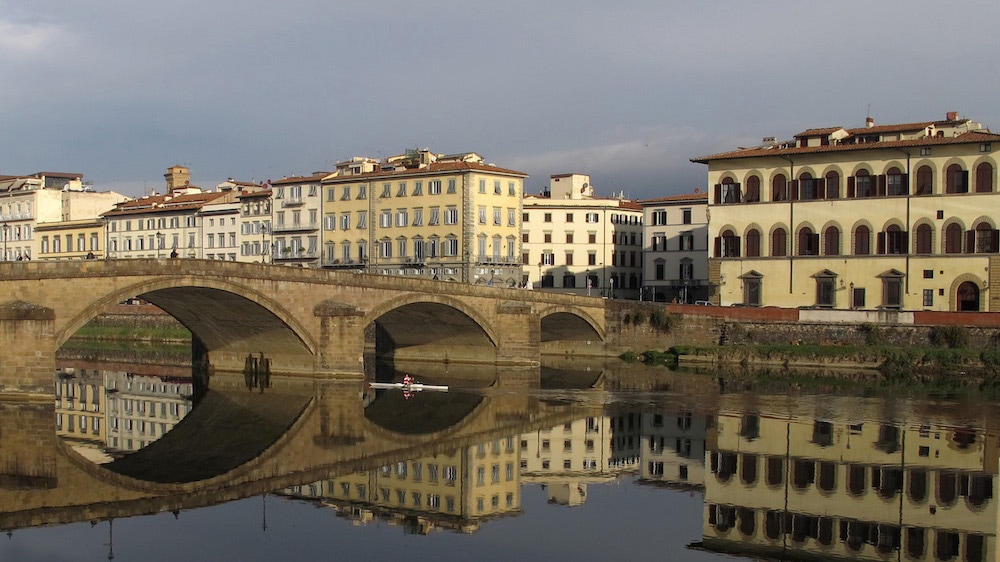The Arno and its bridges are among the most characteristic images of Florence. One of the most famous images of a city famous all over the world for its architecture and culture. The very special relationship that binds the city of Florence with the bridges it houses has ancient and deep roots: the first bridge, in fact, was built around the middle of the first century BC, immediately after its foundation, and made it possible to create a link between the two banks of the Arno. It is thanks to the presence of numerous bridges that Florence breathes an air of harmony and continuity.

The bridges of the city are not only excellent roads, but also magical places where you can admire Florence from different perspectives and capture every little detail. Each of them has a unique history, also made of destruction and rebirth, which has made them real monuments loved and appreciated all over the world.
Let’s discover them together between history, architecture and curiosity.
Ponte Vecchio
The Ponte Vecchio is perhaps the most famous bridge in Florence and is certainly among its most important architectural structures. It connects Via Por Santa Maria with Via de’ Guicciardini and its name is due to the fact that it was “older” at the time when the bridge was built to the Carraia, then called “new bridge”. In addition to its historical value, Ponte Vecchio has always had a central role in the city’s road system, so much so that in the past it connected the Roman Florentia with Via Cassia Nuova commissioned by Emperor Hadrian.

Ponte Vecchio, Firenze
Varlungo Bridge
The Varlungo Bridge consists of a two-way viaduct about 375 meters long, made entirely of steel and reinforced concrete. Its construction dates back to 1979 by the engineer Luciano Scali and the architect Adriano Montemagni, who designed it to respond to many road needs; The bridge, in fact, connects different areas with each other and is composed of two elevated highways and a low central road dedicated to local traffic.

Ponte Giovanni da Verrazzano
The Ponte Giovanni da Verrazzano takes its name from a well-known Tuscan navigator and, after the Ponte di Varlungo, it is the most upstream of the town of Florence. 141 meters long, it is also built with steel and reinforced concrete. Its construction, finished in 1970, was carried out by engineers Vittorio Scalesse and Carlo Damerini and architect Leonardo Savioli. Its structure consists of three parts: the first two start from two opposite banks and are joined by the central metal part, while the third is intended for pedestrians.

Bridge of San Niccolò
The Bridge of San Niccolò was built between 1836 and 1837 near the homonymous San Niccolò fishing from which water was taken to operate the mills inside the city walls. Initially it was a suspension bridge, supported only by metal ropes stretched between one bank and the other of the Arno, named Ponte San Ferdinando in homage to Grand Duke Ferdinando III of Tuscany.

Shortly after the construction, in 1844, it was overwhelmed and destroyed by a strong flood; that is why, in 1853 before and in 1890 then, it was rebuilt and modified according to the needs of the time and renamed as Ponte di Ferro. The current name dates back to the end of the Grand Duchy.
Just like all other Florentine bridges, the San Niccolò Bridge was bombed by the retreating Germans in 1944; subsequently, it was rebuilt with the current reinforced concrete structure and a single arch under the supervision of Riccardo Morandi.
Ponte alle Grazie, Florence
Since the bridge is characterized by crossing a natural rapid of the river Arno, its batteries have been lowered and rest on a stony platform that is constantly modified because it serves to contain the descent downstream of the many boulders that, in case of heavy floods, they could cause serious damage.
Ponte Santa Trìnita
According to Giovanni Spadolini, the Ponte Santa Trìnita in Florence is among the most beautiful bridges in Italy and among the most elegant in Europe; it connects Piazza Santa Trìnita with Piazza de’ Frescobaldi, and exactly like the nearby Basilica Santa Trìnita and the homonymous square has kept in the pronunciation of the name the accent on the first “i”, following the Latin usage.

Initially made of wood at the behest of the Frescobaldi family, it gave way a few years later under the weight of the crowd who were watching a show set up on the Arno. Rebuilt in stone, it collapses again because of the great flood of 1333 that saves only Ponte delle Grazie. Another destruction dates back to 1557, also because of a flood, followed by a further reconstruction by Bartolomeo Ammannati designed by Michelangelo between 1567 and 1571. The new structure features a majestic line of arches and elegant support pillars, as well as four allegorical statues as decorations of the corners.
Unfortunately, Ponte Santa Trìnita was also destroyed by the retreating Germans in 1944. In 1952, thanks to the architect Riccardo Gizdulich and the engineer Emilio Brizzi, it was brought to light in all its current beauty.
Ponte alla Carraia
The Ponte alla Carraia is one of the few bridges in Florence that cross the Arno between the historic center and the Oltrarno district and was the second to be built immediately after Ponte Vecchio (initially called Ponte Nuovo).

According to some testimonies, its realization took place in 1218 by the work of Lapo Tedesco, and was later destroyed by the flood of 1274. It has a very similar history to that of Ponte Santa Trìnita: in 1304 it gave way because of the weight of the crowd, was rebuilt and then razed by the flood of 1333 and, after a further reconstruction following a project by Giotto, was destroyed again in 1557. Since work was already being done on the Ponte Santa Trìnita, Ponte alla Carraia was also rebuilt thanks to Ammannati.
After being mined by the Germans, who decided to blow it up to prevent the passage of the Allied troops, it was rebuilt a last time in 1948 with its current five-arch structure thanks to the architect Ettore Fagiuoli.
Ponte Amerigo Vespucci
The Amerigo Vespucci Bridge joins the Amerigo Vespucci Lungarno to the Soderini Lungarno and is one of the most modern bridges in Florence. It is distinguished by its sober lines, which make it very similar to a ribbon stretched between one shore and another; this is because, according to the project of architects Giorgio Giuseppe Gori, Enzo Gori and Ernesto Nelli and engineer Riccardo Morandi, The bridge should symbolize the tacit coexistence between the old and the new without interfering with the visual balance that characterizes all of Florence, with its historical structures surrounded by contemporary works.

Ponte alla Vittoria
The Ponte alla Vittoria is located near the entrance square to the Parco delle Cascine, outside the historic center. The first structure dates back to 1835, commissioned by Grand Duke Leopold II in honor of San Leopoldo, and consisted of a suspension bridge and placed close to the old city walls with a great commercial role, since it connected the main trade routes.

Initially made of metal, the bridge enjoyed four pillars surmounted by marble lions in neoclassical style. During the restoration, later, two of the four lions were moved and are currently located at the entrance of the avenue of Poggio Imperiale, near Porta Romana.
Its name is a tribute to the battle of Vittorio Veneto, which marked the end of the First World War, after which the bridge was practically rebuilt. Another reconstruction, due, was carried out after the Second World War and gave the bridge its current reinforced concrete structure, with three arches and bronze parapets.
Footbridge of the Islet
The Passerella dell’Isolotto, also known as Passerella delle Cascine, is a pedestrian bridge built in 1962 to connect the district of Isolotto with the center of the Parco delle Cascine. The initial project is the engineers Carlo Damerini and Vittorio Scalesse but, over the years, the bridge has been restored several times, mainly because it is still open to the transit of mopeds and motorcycles.

Its one-span structure is daily crossed by hundreds of people who go to work or the University because of its strategic location, halfway between the two closest bridges, namely the Victoria Bridge and the Indian Bridge.
Ponte all’Indiano
The Ponte all’Indiano connects the districts of Peretola and Isolotto through a fast road. It was built between 1972 and 1978 to a design by architects Adriano Montemagni and Paolo Sica and engineer Fabrizio de Miranda and can be accessed through a special viaduct, called the “Indian viaduct”.

It is a one-of-a-kind cable-stayed bridge in terms of the type of its static structure: it is equipped with a main span supported by overhangs, that is, high-strength steel cables, and rigid steel plate.
Ponte Rosso
The Red Bridge owes its name to the ancient bridge built with red bricks on the Mugnone stream, later replaced with the current stone bridge. From here, in 1765, entered the triumphant Grand Duke Peter Leopold, from Vienna.

Just like the other bridges in Florence, Ponte Rosso was destroyed during the Second World War, which has also been rebuilt and is now the centre of intense car traffic. Enjoy Florence with its bridges crossing one of the most beautiful cities in the world.
Copertina: portaamare




